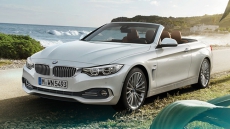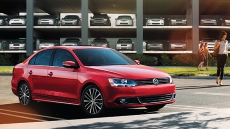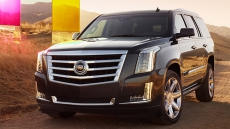The Vancouver International Auto Show (VIAS) returned to the Vancouver Convention Centre for its 95th year, and was quite bigger, better, and greener than ever before.
“The largest consumer show in Western Canada is 25 per cent larger, a reflection of a British Columbia auto industry that is sophisticated and growing,” said Blaire Qualey, president and CEO of the New Car Dealers Association of BC, that helped put together the show.
Fittingly, since it took place in BC, VIAS featured a heavy focus on alternative-energy automobiles fuelled by diesel, electricity and even hydrogen. In fact, the Automobile Journalists Association of Canada (AJAC) created a category for the Canadian Green Car of the Year (CGOTY) award, for an automobile that is environmentally-friendly and meets the needs of the average Canadian consumer. The inaugural honour went to the 2015 Kia Soul EV, announced at a press conference on opening day.

After being crowned, the Soul EV tagged along with the annual AJAC EcoRun happening alongside the auto show. Taking place on Vancouver Island, the event encompassed fuel-efficient vehicles of all classes and types, whether they are powered by a small gasoline engine or a hybrid electric motor.
The purpose of EcoRun is to inform customers of all the green options available to them in the marketplace, and also demonstrate driving techniques that save money at the pump and reduce emissions at the same time.
But back to VIAS for a moment. For 2015, there were more than 30 regional debuts from almost every major manufacturer. Toyota was first up to present, and unveiled to BC audiences for the first time the Toyota Fuel Cell Vehicle Concept. Providing inspiration for the production Toyota Mirai – already on sale in Japan and about to launch in the United States – the Mirai was actually tested in the -30˚C weather of Yellowknife in the Northwest Territories. Power is created by a chemical reaction between oxygen and hydrogen that leaves only water as a by-product, and the space-age-looking sedan can travel up to 500 kilometres between fill-ups.
Audi is also getting in on the clean energy movement with the A3 Sportback e-Tron. The company’s first plug-in hybrid, it may look remarkably like a standard A3 but houses a 1.5-litre turbocharged engine combined with a 75-kilowatt electric motor under the hood producing 204 net horsepower and 258 lb-ft of torque.
No stranger to the world of plug-ins is Porsche, which now has three in its stable, including the hybrid 918 Spyder. One of these $1.3 million dollar supercars was on display upstairs in the expanded ballroom space, representing a different take on the hybrids segment. Utilizing a 4.6 L V8 engine mated with two electric motors, this partially electric beast cranks out an unbelievable 887 hp and has a top speed of approximately 340 km/h.
One of only two already sold in the province, the 918 was unfortunately absent from EcoRun that kicked off the day following the VIAS media preview on March 25. The rest of the 20 vehicles from 13 different automakers lined up at Jack Poole Plaza on a rainy Vancouver morning, right down the street from the convention centre, for an early presentation introducing the event to participants and members of the public.

“One of the great things about the AJAC EcoRun is it demonstrates that saving money on fuel – and helping save the environment – is within reach for anyone. You don’t have to buy an electric vehicle or a hybrid, although there’s nothing wrong with that – you just have to follow some simple tips,” says Ian Jack, managing director of communications and government relations for CAA National, one of the sponsors of EcoRun.
Pouring rain didn’t deter 20 journalists from piling into each of the cars, trucks and SUVs entered, and setting off towards the Horseshoe Bay Ferry Terminal in West Vancouver to start the two-day journey encompassing roads in around both Victoria and Vancouver. The vehicles were outfitted with proprietary data loggers from fleet monitoring equipment specialist FleetCarma, precisely measuring real-world fuel economy throughout several established routes.
Six legs of driving, involving city and highway roads, were evaluated: from Nanaimo to Duncan, Duncan to Langord, Langford to Victoria, Victoria to Swartz Bay, Tsawwassen to Steveston, and Steveston back to Vancouver. There was also an unlogged portion of the trip at Western Speedway, where a small slalom course was set up in the parking lot to prove that eco-friendliness and performance don’t have to necessarily be mutually-exclusive.
Overall, the CGOTY Kia Soul EV ($39,960) was one of the most efficient entrants logging an electric equivalent average of 1.62 L/100 km over a couple of days. The new-for-2015 EV has an approximate range of 149 km on a full charge and produces 109 hp and 210 lb-ft for quick acceleration.

Representing the plug-in extended range electric vehicles, the Chevrolet Volt ($42,450) logged an impressive 3.81 L/100 km. Perfect for anyone suffering from range anxiety, the Volt can travel up to 61 km on electricity alone before the gasoline engine kicks in for assistance.
Most people wouldn’t associate the racy Ford Mustang ($33,799) with green motoring, but Ford’s line of EcoBoost engines are swaying popular opinion by creating big power from small power plants. The 2.3 L in the Mustang EcoBoost makes 310 hp and 320 lb-ft of torque while still managing to achieve 8.54 L/100 km during testing.
Driving techniques employed by the journalists to come up with some of the thrifty fuel consumption numbers include simple things such as avoiding aggressive acceleration and braking; planning ahead so you make one longer trip rather than several small ones in a given day; avoiding excessive idling, keeping your tires properly inflated and your vehicle serviced, removing excess weight; and reducing highway speeds.
For more information about the VIAS 2015 and AJAC EcoRun, visit vancouverinternationalautoshow.com.







